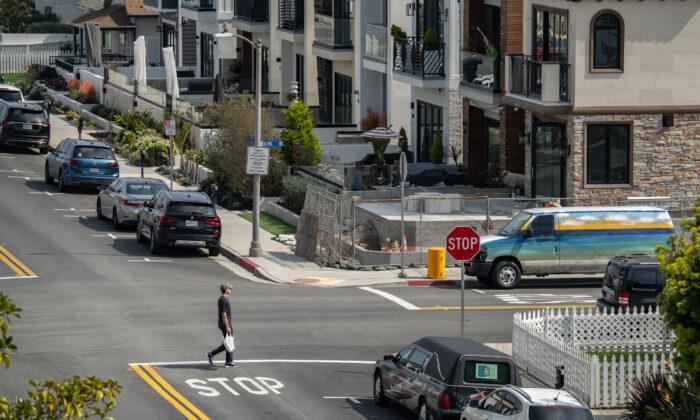A proposal that would change the way California approaches affordable housing is receiving broad support from Democratic lawmakers and is now closer to reaching the governor’s desk after passing the Senate.
Introduced by Senator Aisha Wahab (D-Hayward), Senate Bill 555, also known as the Stable Affordable Housing Act of 2023, proposes a 10-year goal of creating 1.2 million units of social housing through a combination of acquisition and new development, with half of the units created within 5 years and at least one-third of those affordable for what are described as extremely and very low-income households.
“We need a multi-faceted approach to the ongoing housing affordability and homelessness crises, and SB 555 is just that,” Wahab told The Epoch Times in an email June 19. “With the overall impact being an increase in the number of permanently affordable units available to lower-income residents.”
The bill passed the Senate by a vote of 31-8, with the sole Democratic vote in dissent coming from Sen. Marie Alvarado-Gil (D-Jackson), and is now under consideration by the Assembly, with a hearing scheduled with the Committee on Housing and Community Development.
If approved, SB 555 would establish the California Social Housing Fund to accomplish its goals and would require the Department of Housing and Community Development to develop, adopt, and submit to the Legislature a plan to do so by January 1, 2025.

Annual updates would be required from the department, starting January 1, 2026, due to the Legislature and the governor.
Supporters include a list of more than a dozen nonprofits focused on homelessness and affordable housing, including the Council of Community Housing Organizations and the California Community Land Trust Network.
“The private housing market has failed to meet the needs of millions of California residents for homes they can afford,” said a joint press release issued by supporting nonprofits Tenants Together, Housing Now! California, and Public Advocates. “The solution is to create housing sheltered from these market forces.”
The groups are calling for below-market rents that are affordable for all income levels and avoid traditional housing markets that some say are influenced by speculative investors.
Statistics provided in the proposed legislation indicate that more than one-quarter of the renters in California spend more than one-half of their income on rent.
Owning a home is a mathematical impossibility for many workers in the state, according to economists, who point to a disconnect between the amount of income families bring in and a median home price in California of $728,000, as reported by Zillow—an online real estate listing firm.
Republican lawmakers broadly opposed the legislation and warned that if passed, it will contribute to the housing problem instead of addressing it, as the bill would require the state to buy homes as part of the program to provide affordable social housing units, effectively increasing competition for available houses.
“SB 555 pushes the dream of home ownership even further out of reach for everyday Californians,” Senate Minority Leader Brian Jones (R-San Diego) told The Epoch Times by email. “Under this over-reaching bill, the state would purchase thousands of existing homes and reduce our already strained housing supply, driving up prices even more.”

Critics say the issue lies in a lack of supply and new development, with not enough focus on the latter in the proposal to solve the problem.
“The solution to the housing shortage is the construction of new homes, not the state competing with its own citizens looking for an affordable place to live,” Jones said. “I stand in strong opposition to this bill.”
Increasing the supply of housing has been a persistent problem in the Golden State, with developers pointing to strict environmental regulations combined with costly, lengthy permitting processes as primary factors inhibiting new development.
The subsequent decades saw significant growth in population and housing development, with expansions in all major metropolitan areas. Statistics show migration from other parts of the country continuing at a steady pace during the 20th century, with families flocking to the state.
“Things were relatively easy to build in California in the ‘60s and ’70s ... and that’s where we got the reputation as the land of opportunity,” Larry G. Salzman, director of litigation for the Pacific Legal Foundation said in the film. “The California dream, people could move here and make a great life, but that’s hard to find today because of the cost of housing.”

Environmental laws including the California Environmental Quality Act, better known as CEQA, are often cited as obstacles to construction, according to experts.
“Every year since 1970, whether it’s the environmental laws like CEQA, or whether it’s local laws like zoning laws, they’ve gotten more complicated, more dense, more expensive to comply with, and they allow less and less building,” Salzman said.
Developers report similar concerns and note the complications associated with the process are driving some from the business.
“The number one reason why I stopped developing housing in California was that in order to get projects approved, it was so long and so expensive that a small developer like myself doesn’t have the capital to buy property and hold it for two or three years and see if it will get approved,” Jim Righeimer, developer and former mayor of Costa Mesa, said in the documentary.
As critics and supporters discuss the possible consequences and benefits of the bill, lawmakers in the Assembly await the opportunity to debate the proposal.
SB 555 was referred to the Assembly’s housing committee on June 15, and the group is scheduled to discuss the proposal June 28. If passed, the Assembly will vote on the bill later this summer, and the legislation would require approval by the governor before becoming law.





